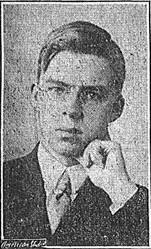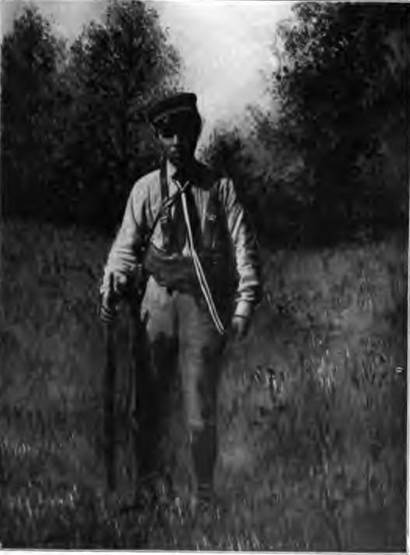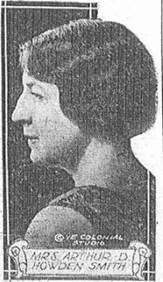[Arthur D. Howden Smith was one of the best authors writing for Adventure. He had a tendency to create series – with Captain McConaughy fighting the Germans in World War 1; the sword Grey Maiden repeatedly turning up across history, and Swain the Viking being the three most popular. He was a journalist and historian as well. On his 125th birthday, here’s a profile of the writer and his work. After the break.]
 |
| Arthur D. Howden-Smith c. 1908 |
Arthur D. Howden Smith was born on 29 December, 1887, in New York. He was from an old New England family with roots in the sailing business. At the age of seventeen, he became an apprentice at the New York Evening Post. He decided to become a reporter, and having met Balkan emigrants in the cafes of New York, decided to make a trip to Macedonia.
Macedonia was then in revolt against the Turkish Empire, and Howden Smith left for Europe, determined to be a war correspondent. When he reached Sofia, he met a council and asked for permission to go with a rebel band (cheta), the committee was at first disinclined to give permission.
“You are a small man,” said Dr. Tartartcheff. (Arthur Howden Smith was 5’ 7” and weighed about 160 pounds). “Do you think you could stand the work? It is very difficult. You cannot rest. The askares (soldiers) follow you, always. You wear sandals which do not protect your feet. Often, you must go without food. When you are tired to weariness, it is your bread that you throw away, that you may not have to sacrifice any of your ammunition. It is a hard life, sir, and a thankless one.
You do not understand the kind of warfare the Turks wage. It is not such as Western Europe knows. There is no mercy shown. It would do you no good to be a non-combatant. You would be slain, just the same, if they caught you. The askares never take prisoners. You are young and you have life before you. Think about it. Is it worthwhile? Remember you are not one of us; we are not your people. Why should you risk your life in an alien cause? There can be no middle course for the man who goes into Macedonia. He either goes with the Turks, or he goes with the chetniks, and if he goes with the chetniks, he goes armed.”
“I understand the risks,” I said. “I know what they will be and I am willing to take them.”
 |
| Arthur D. Howden Smith dressed in the rebel uniform of the Macedonians c. 1907 |
He spent the year in the Balkans, roaming with the cheta, and fighting with them. With this experience, he became an “expert” on the Balkan problem, and went back to New York, where he wrote a book, Fighting the Turk in the Balkans, on his experiences. George Haven Putnam, the publisher of G. P. Putnam’s Sons, saw the manuscript when it was only two-thirds complete, sat up half a night reading it and decided to publish it.
This connection also probably led to him writing articles for Putnam’s magazine on different subjects ranging from the Balkan situation to wireless telegraphy and electric power.
From 1908 to 1915, he was a reporter on the New York Evening Post. 1911 was the year of his first appearance in Adventure, and by 1913 he had sold four non-fiction articles to Adventure, along with three short stories. During this time, he was also writing newspaper articles on corruption in New York City politics.
From 1918 to 1920, he was political and Washington correspondent of the New York Globe. The gap in employment may be explained by service in World War 1; I was unable to find any records of this; other than the fact that a draft registration in his name exists. After the war, he became a correspondent for the Evening Post.
 |
| Nora Howden Smith nee Pinkney |
In 1912, he married Nora Pinkney, and they had a daughter, named Nora after her mother. Nora died as a child, sometime in the 1920s. As far as I know they did not have any other children. After this period, I couldn’t find many facts about his life. His World War 2 draft card mentions his wife’s name as Dorothy, but I couldn’t find any record of such a marriage.
 |
| Arthur D. Howden Smith c. 1918 |
The only paper trail he left behind that I found was the books and stories that he wrote. As a historian, he wrote biographies of John Jacob Astor, Commodore Vanderbilt, Lt. Gen. Winfield Scott and Colonel House. But it is in his stories for Adventure that we are interested, and the highlights are described below.
The man was a serial writer, and he kept writing series – starting with Miles McConaughy, a Cornish captain who fought the Germans. I haven’t read any of these stories.
His next set of stories around the same character was The Doom Trail and Beyond the Sunset, both novels that appeared as serials in Adventure. The hero of these stories was Harry Ormerod, an outlaw in England who escaped to America.
Next came the stories of Swain the Viking, in 1923. The first five stories were collected in a book, Swain’s Saga. From 1923 to 1925, he wrote at least seventeen stories in this series, which was based on the Orkneyinga saga. Swain is a determined, clever man who works on his own, going from losing everything to being a king maker and ends with him dying as he lived. These are grim stories, with death and revenge being the themes.
In between this series came his best work, Porto Bello Gold, which is a prequel to R. L. Stevenson’s classic, Treasure Island. It was published as a serial in Adventure before being published as a book. It was very popular in its time; WorldCat lists 28 editions, including translations in German and Polish. Sadly, it is almost unknown today, which it doesn’t deserve. The hero of Porto Bello Gold is the young Robert Ormerod, son of the Harry Ormerod, the hero of earlier stories. This is in print today, but if you hang around EBay, you may be able to snag a copy of the 1924 edition for less than or the same price as the new reprints. The 1924 edition has coloured plates and illustrations by H.C Murphy, an illustrator who worked for Adventure.
After Swain the Viking came the stories of the Grey Maiden, a sword. The sword itself was not magical; it passed through history with a series of owners and the stories describe incidents in history where the owners of the sword battled. There is a legend about the sword that a man owning the sword cannot die by another sword. An excellent series of nine stories takes us from Ancient Egypt to classical Greece, from there to Ancient Rome, to Hannibal’s army fighting the Romans, back to the end of the Roman Empire, thence to the Arabian desert, to Scandinavia of the Vikings, to Italy in the Middle ages and from there to Elizabethan England just after the Spanish Armada. The first story in the series, The Forging, is available online at the Black Mask magazine site. You can read the rest of the stories online at OpenLibrary, which has a scan of the 1929 edition.
He continued writing for Adventure well into the 1930s and 1940s, including more stories of Swain the Viking. Since he had killed off Swain at the end of the earlier series, these tales of Swain were presented as incidents that occurred before his death. As far as I know, the later tales were not series stories. In between, he wrote another book based on a character, Allan Breck, from R. L. Stevenson’s Kidnapped.
Arthur D. Howden-Smith passed away on December 18, 1945.
Links to books in print:
[Ignore the cover on the book in the middle, the book is indeed Porto Bello Gold.]
Another excellent article on one of ADVENTURE'S best writers. Arthur Howden Smith is a big favorite of mine and has been unjustly forgotten.
Sai, you may want to check the posting of your latest article. The Henry Oyen piece has gotten mixed in with the Howden Smith post, etc. When I click on Oyen, I get the Howden Smith.
Fixed.
Hey Sai, I really think what your doing to discover these writers is a great thing. I find that Smith's best story is over at Everybody's for 1923 The Bucoleon Treasure an excellent tale serialize for 6 months I think. I have the bound Vol's for that year, nice to be able to read it all. They have a nice section in those years talking about the new authors they have within. Like L. Patrick Green etc, good stuff and photos too.
I haven't read The Bucoleon Treasure. I enjoyed the Grey Maiden and the Swain stories, and Porto Bello Gold was a lot of fun too.
Something to look forward to.
Jonathan, could you post some of that biographical information on your blog?
I just finished Grey Maiden yesterday.
Why didn't they include the first story into the collection ? Kind of an important thing to leave out.
Dunno why, but as I said, the first story is available online.
I see that you enjoyed the stories. Any one of them stand out for you?
Ah, sorry I didn't notice your responce earlier, there doesn't seem to be any notification for when you get responded to in the comments section of blogspot.
The earlier stories are my favourite in the collection, but all are good. "Thord's wooing" for example could just as easily have been expanded into a full novel, given how well constructed it is.